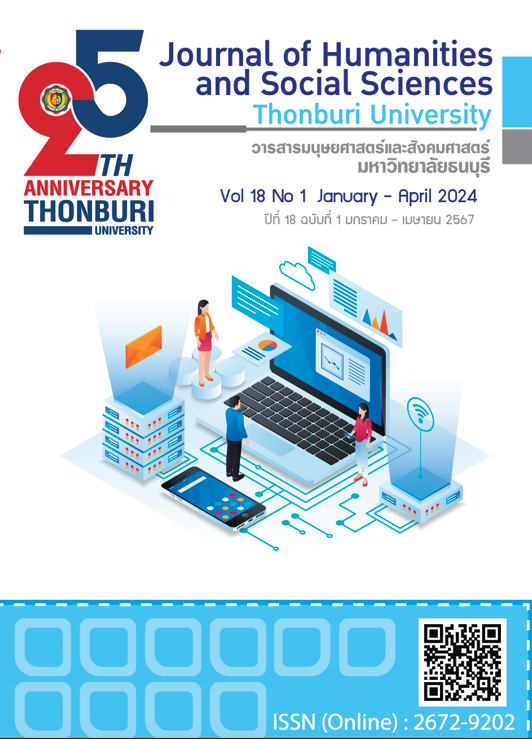การบริหารเงินทุนหมุนเวียนและความสามารถในการทำกำไรของธุรกิจเกษตรและอาหาร ในตลาดหลักทรัพย์แห่งประเทศไทยในช่วงก่อนและหลังโควิด-19
คำสำคัญ:
การบริหารเงินทุนหมุนเวียน, นโยบายเงินทุนหมุนเวียน, วงจรเงินสด, อัตรากำไรสุทธิ, โควิด-19บทคัดย่อ
การบริหารเงินทุนหมุนเวียนมีความสำคัญต่อสภาพคล่องและความสามารถในการทำกำไรของกิจการโดยเฉพาะอย่างยิ่งในช่วงที่เกิดภาวะวิกฤตทางเศรษฐกิจ งานวิจัยนี้มีวัตถุประสงค์เพื่อศึกษาความสัมพันธ์ระหว่างการบริหารเงินทุนหมุนเวียนและความสามารถในการทำกำไรของบริษัทจดทะเบียนในกลุ่มอุตสาหกรรมเกษตรและอาหารในตลาดหลักทรัพย์แห่งประเทศไทยในช่วงก่อนและหลังจากสถานการณ์การแพร่ระบาดของโควิด-19 โดยใช้ข้อมูลจากงบการเงิน รายไตรมาสตั้งแต่ พ.ศ. 2561 - พ.ศ. 2565 ของบริษัทจดทะเบียนจำนวนทั้งสิ้น 40 บริษัท ผลการวิเคราะห์ Pooled OLS Regression แสดงให้เห็นว่า การบริหารเงินทุนหมุนเวียนมีความสัมพันธ์กับความสามารถในการทำกำไรซึ่งวัดโดยอัตรากำไรสุทธิของบริษัทในหมวดธุรกิจอาหารและเครื่องดื่ม โดยการลดระยะเวลาวงจรเงินสดส่งผลให้อัตรากำไรสุทธิที่สูงขึ้น โดยเฉพาะอย่างยิ่ง การลดระยะเวลาเก็บหนี้และเพิ่มระยะเวลาชำระหนี้ ส่วนนโยบายลงทุนแบบผ่อนคลายและนโยบายจัดหาเงินซึ่งใช้แหล่งเงินกู้ยืมระยะสั้นเพื่อลงทุนในสินทรัพย์หมุนเวียนในสัดส่วนที่สูงทำให้อัตรากำไรสุทธิเพิ่มสูงขึ้น ผลการศึกษายังพบด้วยว่า การบริหารเงินทุนหมุนเวียนมีความสำคัญต่อความสามารถในการทำกำไรเพิ่มมากขึ้นในช่วงหลังเกิดโควิด-19
References
จิรัญญา ตาวงษ์ และ จิรพงษ์ จันทร์งาม. (2565). ผลกระทบของการจัดการเงินทุนหมุนเวียนที่มีต่อความสามารถใน การทำกำไรของบริษัทจดทะเบียนในตลาดหลักทรัพย์แห่งประเทศไทย: กลุ่มอุตสาหกรรมทรัพยากร. วารสารวิชาการและวิจัยมหาวิทยาลัยภาคตะวันออกเฉียงเหนือ. 12(1): 159-171.
เถกิงศักดิ์ ชัยชาญ และ สรียา วิจิตรเสถียร. (2562). นโยบายการบริหารเงินทุนหมุนเวียนและความสามารถในการทำกำไรของบริษัทกลุ่มสินค้าอุตสาหกรรมในประเทศไทย. วารสารชุมชนวิจัย. 13(2): 91-100.
ปรียานุช กิจรุ่งโรจน์เจริญ. (2558). การบริหารเงินทุนหมุนเวียน: Working Capital Management. วารสารสารสนเทศ. 14(2): 7-19.
อรุณรัตน์ เทวงศา, สุรชัย จันทร์จรัส, และ สุธาสินี สุวรรณภักดิ์. (2560). การวิเคราะห์ความสัมพันธ์ระหว่างการบริหารเงินทุนหมุนเวียนกับความสามารถในการทำกำไรของกลุ่มอุตสาหกรรมการเกษตรและอาหารของไทย. เรื่องเต็มการประชุมทางวิชาการของมหาวิทยาลัยเกษตรศาสตร์ ครั้งที่ 55: สาขาศึกษาศาสตร์, สาขาเศรษฐศาสตร์และบริหารธุรกิจ, สาขามนุษยศาสตร์และสังคมศาสตร์. กรุงเทพฯ. 331-338.
Abbas, M. A. Y., & Larasati, L. (2022). Effectiveness Use of Working Capital During The Covid-19 Pandemic at PT. Mitra Adiperkasa Tbk. Jurnal Mantik. 5(4): 2425-2429.
Brigham, E. F., & Houston, J. F. (2018). Fundamentals of Financial Management (15 ed.). Cengage Learning.
Brigham, E. F., & Houston, J. F. (2020). Fundamentals of Financial Management: Concise (10 ed.). Cengage Learning.
Dalci, I., & Ozyapici, H. (2018). Working Capital Management Policy in Health Care: The Effect of Leverage. Health Policy. 122(11): 1266-1272.
Eljelly, A. M. A. (2004). Liquidity ‐ Profitability Tradeoff: An Empirical Investigation in an Emerging Market. International Journal of Commerce and Management. 14(2): 48-61.
Enqvist, J., Graham, M., & Nikkinen, J. (2014). The Impact of Working Capital Management on Firm Profitability in Different Business Cycles: Evidence from Finland. Research in International Business and Finance. 32: 36-49.
Herdinata, C. (2017). Policy Identification of the Working Capital Management of Medium-Sized Business. Mediterranean Journal of Social Sciences. 8(6): 29-36.
Nazir, M. S., & Afza, T. (2009). Impact of Aggressive Working Capital Management Policy on Firms' Profitability. The IUP Journal of Applied Finance. 15(8): 19-30.
Satoto, S. H., KP, H. N., & WS, S. B. (2022). Working Capital Management before and during the COVID-19 Pandemic and their Effect on Profitability in Manufacturing Companies Listed on the Indonesia Stock Exchange. International Journal of Economics, Business and Accounting Research (IJEBAR). 6(3): 2119-2126.
Setiawan, W. Y., & Hutomo, Y. B. S. (2023). The Impact of the COVID-19 Pandemic on Indonesian Retail Companies' Working Capital Management. KINERJA. 27(1): 1-11.
Phuong, D. H., & Su, J. T. (2010). The Relationship between Working Capital Management and Profitability: A Vietnam Case. International Research Journal of Finance and Economics. 49: 62-71.
Yusra, I., Hadya, R., & Anwar, S. (2023). Analysis of Profitability, Working Capital, Inventory before and after the COVID-19: Empirical Study from the Pharmaceutical Industry. e-Jurnal Apresiasi Ekonomi. 11(2): 283-291.
Zimon, G., & Tarighi, H. (2021). Effects of the COVID-19 Global Crisis on the Working Capital Management Policy: Evidence from Poland. Journal of Risk and Financial Management. 14(4): 169.
Translated Thai References
Chaichan, T., & Wichitsathian, S. (2019). Working Capital Policies and Profitability of Listed Industrials Firms in Thailand. Community Research Journal. 13(2): 91 - 100. (in Thai)
Dhevongsa, A., Chancharas, S., & Suwanapakdi, S. (2017). An Analysis of the Relationship between Working Capital Management and Profitability of the Agro Industry in Thailand. Proceedings of 55th Kasetsart University Annual Conference: Education, Economics and Business Administration, Humanities and Social Sciences. Bangkok. 331-338. (in Thai)
Kitrungrojcharoen, P. (2015). Working Capital Management. Journal of Information. 14(2): 7-19. (in Thai)
Tawong, J., & Channgam, J. (2022). Effects of Working Capital Management on Profitability of Listed Companies in The Stock Exchange of Thailand: Resources Industry Group. NEU Academic and Research Journal. 12(1): 159-171. (in Thai)
Downloads
เผยแพร่แล้ว
How to Cite
ฉบับ
บท
License
Copyright (c) 2023 Pichaya Kanchanalai, Kuntonrat Davivongs, Visit Limsombunchai

This work is licensed under a Creative Commons Attribution-NonCommercial-NoDerivatives 4.0 International License.
ผลงานที่ปรากฎในวารสารฉบับนี้เป็นลิขสิทธิ์เฉพาะส่วนบุคคลของผู้เขียนซึ่งต้องรับผิดชอบต่อผลทาง กฎหมายที่อาจเกิดขึ้นได้และไม่มีผลต่อกองบรรณาธิการ





